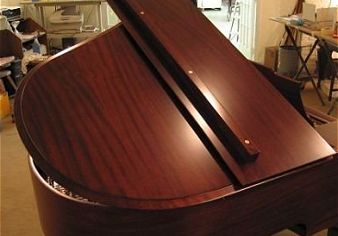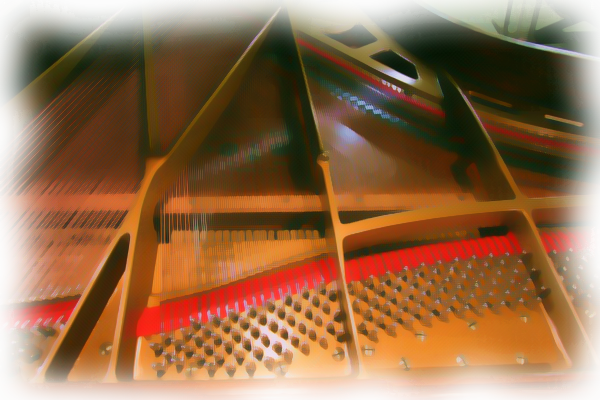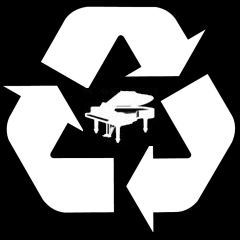What Exactly Is Piano Recycling?
No Need to Abandon Your Piano
 Piano Recycling is a money saving approach to piano restoration that retains, repairs, and then reuses those parts of your piano that have maintained their structural integrity over time. The concept is simple: the goal is to repair, refinish, and refine those parts of a client's piano that have retained sufficient quality and a promise of dependability. Durable parts might need repair, but they do not require more expensive and time consuming procedures such as re-manufacturing or replacement. Our clients pay less while their pianos are rebuilt with strong, reliable parts that were original to the piano, refurbished and once again integrated - recycled - into its structure and mechanics.
Piano Recycling is a money saving approach to piano restoration that retains, repairs, and then reuses those parts of your piano that have maintained their structural integrity over time. The concept is simple: the goal is to repair, refinish, and refine those parts of a client's piano that have retained sufficient quality and a promise of dependability. Durable parts might need repair, but they do not require more expensive and time consuming procedures such as re-manufacturing or replacement. Our clients pay less while their pianos are rebuilt with strong, reliable parts that were original to the piano, refurbished and once again integrated - recycled - into its structure and mechanics.
 'Piano recycling' is a phrase we use to describe a particular approach to the craft known as piano restoration. It is the process of retaining, refurbishing, and reusing those parts of a piano that have maintained their structural integrity over time, through extended use, even through periods of neglect and abuse. With restoration as the goal, piano recyclers approach their work with the intent to identify the parts of the piano that "remain alive," that possess viability and the potential for future use. Parts with integrity are recycled while other parts, such as the plastics that become brittle and felts and hammers that become condensed and moth eaten, are replaced. In other words, in piano recycling, emphasis is placed on preserving the parts of the piano considered valuable, repairable, and able to respond favorably to future possibilities. These recyclable parts are often what we consider to be the 'heart and soul' of the piano, that which makes the piano's restoration and preservation meaningful and worthwhile.
'Piano recycling' is a phrase we use to describe a particular approach to the craft known as piano restoration. It is the process of retaining, refurbishing, and reusing those parts of a piano that have maintained their structural integrity over time, through extended use, even through periods of neglect and abuse. With restoration as the goal, piano recyclers approach their work with the intent to identify the parts of the piano that "remain alive," that possess viability and the potential for future use. Parts with integrity are recycled while other parts, such as the plastics that become brittle and felts and hammers that become condensed and moth eaten, are replaced. In other words, in piano recycling, emphasis is placed on preserving the parts of the piano considered valuable, repairable, and able to respond favorably to future possibilities. These recyclable parts are often what we consider to be the 'heart and soul' of the piano, that which makes the piano's restoration and preservation meaningful and worthwhile.
New is not always Better.
A major reason piano recyclers repair and reuse parts from old pianos is because old pianos were generally made with fine materials. A perfect example of this is with piano cabinets. Today, many piano manufacturers make their cabinets out of a type of particle board. In contrast, old world pianos were made from real wood, worked by hand, and not just any wood, but superior, premium grade lumber harvested from American and European old growth forests. Such materials are increasingly rare today and that fact provides one more reason why we believe old cabinets should be recycled. We know the value is there, and our craft reflects the desire to make that treasure explicit.
 Such cabinets, we find, are almost always not what need replacing. Rather, dents and scratches need to be removed, decomposing varnishes replaced. Of course, this is where the experience and professionalism of the technician comes into play.
Such cabinets, we find, are almost always not what need replacing. Rather, dents and scratches need to be removed, decomposing varnishes replaced. Of course, this is where the experience and professionalism of the technician comes into play.
For example, consider this old piano lid with its stains, scratches, and cloudy varnish. The integrity of the lid is all but completely obscured.
Pianos like this are often condemned to the trash heap because the assessor, seeing only the superficial flaws of the aged surface, fails to discern what hides beneath, namely, the integrity of the cabinet, its incredible beauty.
 The reward for the restorative technician is the enjoyment of having made the aesthetic value of the cabinet visible once again.
The reward for the restorative technician is the enjoyment of having made the aesthetic value of the cabinet visible once again.
We've found that, for the most part, the old world cabinets, themselves, retain their integrity over time. Our part is to recognize that integrity, often hidden behind years of abuse and neglect, and to bring it back into the cultural realm where art and music thrive.
Pianos do not have expiration dates.
Over the years, many of our clients have been professional musicians coming to us with old pianos needing restoration. Some clients owned pianos that survived long careers as the principal or favorite instrument. Some even traveled from city to city as the performance piano, but had 'retired from the stage,' as they say. Retirement for these old pianos came, not because they had been replaced by new or better technology; but because they needed to be restored.
 Once restored, some of these former stage and performance pianos were redefined as parlor pianos, or rehearsal pianos, still expected to perform with rigor and precision as reliable, hard working instruments. The musicians who owned these pianos seemed to love them as old friends. Perhaps they loved them because the pianos had worked and sounded the way they were intended and had done so for a long time. Though they might not openly express their reasons for wanting their pianos to be restored, what made it possible to fulfill our client's wishes, was that, from the outset, their pianos had been built with exceptional skill and superior materials, a combination which enabled the instruments to endure, even between generations.
Once restored, some of these former stage and performance pianos were redefined as parlor pianos, or rehearsal pianos, still expected to perform with rigor and precision as reliable, hard working instruments. The musicians who owned these pianos seemed to love them as old friends. Perhaps they loved them because the pianos had worked and sounded the way they were intended and had done so for a long time. Though they might not openly express their reasons for wanting their pianos to be restored, what made it possible to fulfill our client's wishes, was that, from the outset, their pianos had been built with exceptional skill and superior materials, a combination which enabled the instruments to endure, even between generations.
But it isn't just high-end performance pianos that were built this way. We find it to be the case that most older pianos arrive at our shop hiding superb characteristics. Under scratches and old varnish we find rich, real-wood cabinets, old-growth spruce heartwood sound boards, historical ivory keyboards, and other parts made with materials and resources that are simply not available today at any cost.
 Thus our dedication to piano recycling.
Thus our dedication to piano recycling.
Because the piano must maintain the support of an incredible amount of physical tension, many structural parts of the piano are built for high strength. As a result, these parts can last a long, long time. The internal metal frame is an example.
Let Us Help! Send Us Your Questions.
Try the Piano Restoration Price Calculator.











 There are many good reasons -- some simple, some more complex; some emotional, others purely economical -- as to why piano owners decide to use the Piano Recyclers Discount. Here are some of the reasons we see:
There are many good reasons -- some simple, some more complex; some emotional, others purely economical -- as to why piano owners decide to use the Piano Recyclers Discount. Here are some of the reasons we see:  With their stylish lines and contours, it's not just the sound of a well tuned piano that holds our attention. The cabinets, too, are often preserved as show pieces, even works of art.
With their stylish lines and contours, it's not just the sound of a well tuned piano that holds our attention. The cabinets, too, are often preserved as show pieces, even works of art.  Recent news stories tell of the coming tide of old pianos that need restoring. Piano owners, unaware of the options before them, misinterpret their piano's age and neglect as signs that the piano has become worthless, and so they throw them away. In terms of recyclable parts and restorable pianos, this trend is anything but necessary, and a terrible waste that could be avoided.
Recent news stories tell of the coming tide of old pianos that need restoring. Piano owners, unaware of the options before them, misinterpret their piano's age and neglect as signs that the piano has become worthless, and so they throw them away. In terms of recyclable parts and restorable pianos, this trend is anything but necessary, and a terrible waste that could be avoided. 



